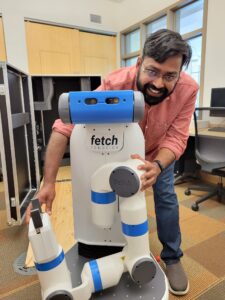
In a significant stride towards the future of technology and human collaboration, the Department of Computer Science at Colorado State University has introduced a state-of-the-art robot, known as Shakey Jr. This project is aimed at unraveling the complexities of human-robot interactions.
The robot was named Shakey Jr. after CSU students suggested names that they thought would best fit the robot.
“To give a bit of context, Shakey, the robot developed by Stanford Research Institute, was one of the first mobile robots that incorporated sophisticated reasoning mechanisms,” said Sarath Sreedharan, an assistant professor in the department. “By adding ‘Jr.’ to the name, it also suggests the need for evolution, while building on the past. While the previous Shakey focused on reasoning about its environment and how to do tasks, this Shakey will be focusing on how to interact with and best help people,” said Sreedharan.
A possible application for Shakey Jr. is to assist with household chores or caregiving responsibilities. The robot could also find utility in manufacturing tasks in a more industrial setting. The robot, designed under the supervision of Sreedharan, is meant to elevate how humans and machines collaborate.
“The fundamental purpose of this robot is to facilitate the study of human-robot interactions,” he said. “Our endeavor involves developing algorithms that empower robots to seamlessly engage with individuals from various walks of life, ranging from robotics experts to those with limited technical exposure.”
The implications of this purpose are far-reaching. Sreedharan plans to undertake a series of experimental simulations that closely mimic real-world scenarios, allowing Shakey Jr. to showcase its ability to respond to diverse human commands and requests.
“Our initial focus,” Sreedharan elaborated, “encompasses two core settings. The first is a simulated home environment, where the robot can assist with household chores and take on caretaking responsibilities. The second involves deploying the robot in industrial settings, aiding workers in manufacturing processes.”
Yet, Sreedharan acknowledges the intricate challenges posed by this venture for himself and his students in the computer science department. Conducting research on robots demands a meticulous blend of technical proficiency and unwavering patience.
For his students, “apart from possessing a strong technical foundation, patience is a quintessential requirement,” he said. “Troubleshooting and fine-tuning a robot’s behavior can be intricate and time-consuming due to the multitude of variables at play. However, the gratification derived from witnessing one’s code materialize into tangible actions is truly exhilarating.”
For those eager to contribute to this pioneering exploration, Sreedharan extends an invitation.
“There are abundant opportunities for students to engage in this endeavor. Interested individuals can reach out to me directly to get involved in this research,” he said.
Looking ahead, Sreedharan envisions a future where robots and technology are seamlessly woven into the fabric of everyday life.
“I envision a future where robotics assistance is universally accessible,” he asserted. “A future where collaboration with robots is as intuitive as working with fellow humans, without necessitating advanced degrees or specialized programming expertise.”
In the corridors of CSU’s Computer Science Department, Shakey Jr. represents more than just a technological innovation. It could signify a steppingstone towards a future where humans and robots collaborate, coexist and elevate the potential of both realms through profound interactions.